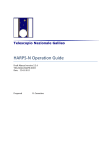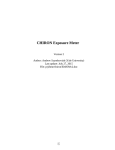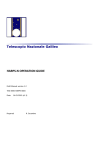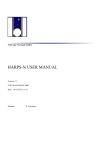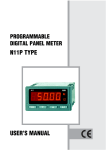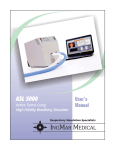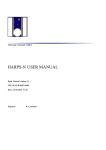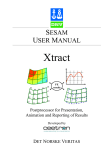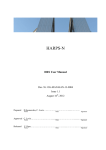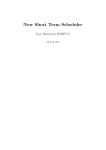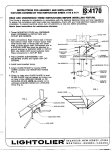Download HARPS-N Operation Guide - Telescopio Nazionale Galileo
Transcript
Telescopio Nazionale Galileo HARPS-‐N Operation Guide Draft Manual version 2.2.7 TNG-‐MAN-‐HARPN-‐0003 Date: 18-03-2014 Prepared R. Cosentino Change Record Issue/Rev. V1.0 V1.1 V1.2 V2.0 V2.1 V2.2.3 V2.2.4 V2.2.5 V2.2.6 V2.2.7 Date 14-12-2012 14-01-2013 04-02-2013 12-02-2013 Section/Page affected First version 22-05-2013 19-11-2013 15-01-2014 18-03-2014 11-09-2014 All document All document Reason/Remarks Autoguider added New sequencer and Labview SW Paragraph 3.5 added New sequencer and expmeter Double star guiding procedure added Minor changes TNG-‐MAN-‐HAN-‐0003 3 Contents 1 2 3 Introduction .............................................................................................................................................................. 4 1.1 Scope .................................................................................................................................................................... 4 1.2 Additional information ................................................................................................................................. 4 1.3 Contact information .................................................................................................................................. 4 Before the observations ....................................................................................................................................... 5 2.1 The Observation blocks preparation ...................................................................................................... 5 2.2 The Sequencer GUI (initialization and operation) ........................................................................... 6 2.2.1 Initialization ............................................................................................................................................. 7 2.2.2 Sequence Control buttons .................................................................................................................. 8 2.2.3 Instrument control buttons ............................................................................................................... 8 2.2.4 Other changes .......................................................................................................................................... 8 2.2.5 Before the calibration .......................................................................................................................... 9 2.2.6 The standard calibration (daily calibration) ........................................................................... 10 Observations .......................................................................................................................................................... 11 3.1 The start night ............................................................................................................................................... 11 3.2 The focus procedure ................................................................................................................................... 11 3.3 The pointing model procedure .............................................................................................................. 12 3.4 The science OB execution ......................................................................................................................... 12 3.5 The Observing Control Software (OBS) ............................................................................................. 13 3.5.1 3.6 Common situation: The pointing sends the telescope to the limit switch ................. 13 The Autoguide ............................................................................................................................................... 15 3.6.1 The HARPS-‐N AutoGuider windows ........................................................................................... 16 3.6.2 The Integrated Image window ...................................................................................................... 18 3.6.3 Procedure to guide on narrow double stars by using the mask ..................................... 19 Appendix A -‐ Useful Harps-N webpages .............................................................................................................. 20 Appendix B - Actions of multi task commands ............................................................................................ 20 Appendix C - Actions of focus procedure commands ............................................................................... 21 Appendix D – List of acronyms .............................................................................................................................. 22 TNG-‐MAN-‐HAN-‐0003 4 1 Introduction 1.1 Scope This User Manual is intended to give all necessary information to potential users of the HARPS-‐N instrument, to help them to use the instrument and manages the observation at the TNG telescope. The following documents are closely related to this manual and should be consulted as well: • • • • The HARPS-N User Manual (TNG-MAN-HARPN-0002) The HARPS-N Startup Manual (TNG-MAN-HARPN-0001) The New Short Term Scheduler User Manual (NSTS) The DRS User Manual (OG-MAN-HAN-13-0004) Both are available t hrough the TNG web page http://www.tng.iac.es/instruments/harps/ 1.2 Additional information The latest information updates about the HARPS-‐N instrument can be found on the HARPS-‐N web pages http://www.tng.iac.es/instruments/harps/ 1.3 Contact information Feedback on this User Manual from users is encouraged. Please email to [email protected] TNG-‐MAN-‐HAN-‐0003 5 2 Before the observations Starts up the system following the instructions of the “HARPS-‐N Quick Start Guide” and take care to read all the advices reported at the beginning of the manual. 2.1 The Observation blocks preparation From the NSTS the observer can prepare the sequence of observation blocks of the night (Figure 1). The target can be inserted directly in the NSTS or by using a catalog file that contains the objects information. The format of the catalog file is an ascii file and the fields separator is a TAB (ascii code = 9). The fields of the catalog are shown in Table 1, the mandatory fields are shown in bold format. An example of catalog file is shown in the HARPS-‐N webpage: (http://www.tng.iac.es/instruments/harps/data/SpStdHARPSN.cat) Table 1-‐ Catalog file entries name alpha delta mualpha mudelta mv bv TypSp radvel snr spectr remarks acquisition equinox progid piname exptime object code right ascension (nn:nn:nn.nn) Declination (nn:nn:nn.nn) proper motion alpha(arcsec/year) proper motion delta (arcsec/year) magnitude V Bv spectral type mean radial velocity (KM/sec) or -‐99999 Signal/Noise (550nm) spectral type for the mask(two chars only) Remarks Acquisition template (es. HARPN_ech_acq_objA) Equinox program identificator (es. TAC_xx) PI name Exposure time TNG-‐MAN-‐HAN-‐0003 Figure 1 -‐ Short Term Scheduler 6 2.2 The Sequencer GUI (initialization and operation) After the startup of HARPS-‐N the instrument is ready to the initialization of the subsystems and the start of operation. The sequencer GUI (Figure 2) is divided into several sections: • The sequence control buttons, for the interaction with the observing blocks • The Instrument control buttons, for the interaction with the HARPS-‐N’s subsystems • The observation Execution logs window, where the commands execution and the errors are shown • The acquisition control buttons, (expose, repoint, etc), allows to do actions related with the autoguider’s image visualized by the DS9 application. The DS9 application shows the autoguider’s image and interacts with the sequencer. During the command execution the status is visualized into the observing status window and, at the end of execution, a bell sound confirms the correct execution of the command (if the sound is a horn noise, this means that something goes wrong and an error should be shown in the observing status window). TNG-‐MAN-‐HAN-‐0003 7 2.2.1 Initialization From the instrument control section, click on the LCU Init button and wait until the command ends. Then click on the AG Init button and wait until the command ends. The system now is ready to calibrations (but not for the observations). Figure 2 -‐ The Sequencer GUI Note-‐1: The red log “Failed to fetch data from telemetry!” is not an error and can be ignored as error if appears during calibrations or in acquisition with exposure time less than 5 seconds. Note-‐2: The yellow log “[…] Warning Final AG guide FITS file not found!” is a warning that don’t affect the observation (we are working to fix this bug) Table 2 -‐ Acquisition Control buttons Add magnitude Save Focus Cancel Focus Expose Get infos from DS9 Get DSS fields in DS9 Repoint Go Automatic acquisition Increases/decreases the value of the magnitude of the selected star send to OCS the command that update the serrurier focus Moves M2 to the position prior to the focus procedure execution Take a new image with the AG camera Take coordinates and FWHM from the point clicked in the DS9 image Visualize the compass in the DS9 put the point clicked in the DS9 image into the fiber position and acquire a new image put the point clicked in the DS9 image into the fiber position and start the autoguider Selects , put in the fibre and start the acquisition of the brightest star of the field TNG-‐MAN-‐HAN-‐0003 8 2.2.2 Sequence Control buttons Next OB executes the next block available of the NSTS Single OB if checked executes one block when the user click on Next OB button Queue Mode if checked executes a series of NSTS blocks (according with the NSTS rules) when the user clicks on Next OB button Terminate exposure ends the current exposure and save the scientific frame Abort block aborts the current block 2.2.3 Instrument control buttons Start night button executes the Telescope Start night and the Instrument start night Start Tel button executes the Telescope Start night Start Ins button executes the Instrument start night Start EM button starts the exposure meter and open the GUI Dust Cover buttons Open and Close the dust cover Note: The Start Night button includes the preparation to observation of the telescope and of the instrument. With the new two buttons the user can do this operation separately by using the Start Tel and the Start Ins Buttons. 2.2.4 Other changes The sequencer now has a feedback with the NSTS. If the NSTS is not in execution the sequencer visualizes a warning. Note: When the sequencer is restarted after an error, the status buttons are not refreshed to the correct status (except the lamps buttons, which are refreshed after a while). The undefined (yellow) status of the other buttons is not real and can be ignored (if the user is sure that the instrument is initialized and ready to work) see Figure 2 . TNG-‐MAN-‐HAN-‐0003 Figure 3 -‐ DS9 terminal with a binary star in the field 9 The compass is represented by the yellow axis, with the orientation shown in Figure 3. 2.2.5 Before the calibration Few minute before the start of calibration (about 10 minutes), the observer has to turn on the thorium lamps. If the elapsed time is less then 10 minutes a warning windows appears; in this case the observer has to wait the time indicated in the popup window. The observer can ignore this warning but can compromise the quality of observation. In the Instrument control section: 1. Click on the Turn ON button of THO1 lamp 2. Click on the Turn ON button of THO2 lamp 3. On the LCU Device Monitor verify the lamps status (Figure 4) TNG-‐MAN-‐HAN-‐0003 10 Figure 4 -‐ LCU Device Monitor A bell sound confirms the correct execution of the command 2.2.6 The standard calibration (daily calibration) The daily calibration is very important to do in the afternoon (about 1 hour before the start of observation). 1. From the NSTS selects the ‘standard calibration’ OB 2. From the sequencer GUI, click in the ‘Next OB’ button. 3. Verify in the DRS if the calibration goes without errors Figure 5 -‐ Thorium1 lamp warm warning Figure 6 -‐ Thorium lamp1 turn off warning TNG-‐MAN-‐HAN-‐0003 11 During the command execution the status is visualized into the observation Execution logs window and, at the end of execution, a bell sound confirms the correct execution of the command (if the sound is a horn noise, this means that something goes wrong and an error should be shown in the observation Execution logs window). The standard calibration procedure is about 11 minutes long. Very important: When the calibration ends, turn off the thorium 1 lamp: 1. Click on the Turn OFF button of THO1 lamp 2. Click on the Turn OFF button of THO2 lamp (if you will not observes in thorium simultaneous mode) 3. On the LCU Device Monitor verify the lamps status (Figure 4) Note: If the TH1 lamp remains in the on state, after a while a warning window appears. The observer can decide if maintain the lamp in on (only if he is using it) or turn off it. 3 Observations 3.1 The start night Before the start of observation the system needs that some processes starts and then the telescope is ready to work in HARPS-‐N mode. 1. Be sure that the system is initialized and ready to work (Start-‐up procedures, in the HARPS-‐N Quick Start Guide) 2. In the sequencer GUI, click in the Start Night button in the Instrument Control section and wait the end of execution of the command. Now HARPS-‐N is ready for observations. Note: The Start Night button includes the preparation to observation of the telescope and of the instrument. The user can do that operation separately by using the Start Tel and the Start Ins Buttons (recommended Action) 3.2 The focus procedure At the beginning of the night, may be suitable do a focus procedure doing the following actions: 1. In the NSTS selects a star from the catalogue and delete the HARPN_ech_obs_all template. The star can be the first object of the observation schedule to save pointing time. I suggest to not selecting a faint object for the focus. In case of doubt ask to the TO if the star is compatible with the focus procedure and the night conditions. 2. Add the HARPN_focus template TNG-‐MAN-‐HAN-‐0003 12 3. From the sequencer execute this OB by clicking the Next OB button. (The sequencer sends the commands to: move the telescope, acquire an image from the autoguider camera and shows the image in the DS9.) 4. Click on the star and then click on the Go button in the Acquisition Image window. (The sequencer sends an offset to the telescope, puts the star in the fiber position, starts the autoguide, executes the focus procedure, moves the M2 mirror at the best position and acquire a new autoguider image) At this point the user can execute the enabled actions (Save Focus, Cancel Focus, Expose, Get infos from DS9 etc) BUT must to click on ‘Save Focus’ or ‘Cancel Focus’ button to end the focus procedure and enable the next button. The focus procedure is about 10 minutes long. 3.3 The pointing model procedure Sometimes the pointing precision can be poor and the telescope could need the execution of a pointing procedure. The pointing procedure must be done in collaboration with the telescope operator (TO) and the TO has to know some information during the procedure. The sequences of actions to manage the pointing procedure are: 1. In the NSTS select a star from the catalog HARPSN-‐PointingModel.cat located in /home/guest/GAPS/CATALOGS 2. Delete the HARPN_ech_obs_all template 3. From the sequencer execute this OB by clicking the Next OB button and tell to the TO when the AG image starts, (this is the critical point of this procedure) : Sequencer: Thu Dec 27 23:12:29 UTC 2012 -> launch AG_expose 4. When the image of the star appears, clicks on the star, then clicks on the Repoint button in the Acquisition Image window and tell to the TO that the offset has been applied. 5. The TO takes note in the VME of the offset applied, the paralactic angle and uses these data in the pointing procedure. 6. Repeat the cycle with another star (from point 1.) until the pointing procedure reaches the precision expected. 3.4 The science OB execution In the execution of a scientific OB the object has to be pointed and centred in the fiber with the intervention of the observer. 1. In the NSTS select a star from the catalog TNG-‐MAN-‐HAN-‐0003 13 2. From the sequencer execute this OB by clicking the Next OB button. (The sequencer sends the commands to: move the telescope, acquire an image from the autoguider camera and shows the image in the DS9.) 3. Click on the star and then click on the Repoint button in the Acquisition Image window. (The sequencer sends an offset to the telescope, puts the star in the fiber position, acquires another image from the auto-‐guider camera and shows the image in the Acquisition Image window) 4. When the image appears, if the star is in the fiber position (red circle), click in the Go button in the Acquisition Image window. After that the sequencer starts the auto-‐guide and the spectroscopic acquisition. When the OB ends, a bell sound confirms the correct execution of the command and the Next Acquisition button turns in active mode. 3.5 The Observing Control Software (OBS) The OCS is the interface to the Telescope Control System (TCS). The interface enables the instrument to send commands to the telescope via the TNG library. Currently HARPS-‐N is able to send three commands; Pointing, AG offsets and M2 offsets to calculate and correct the focus via an automatic procedure. The connections between both systems are completely asynchronous but when the command finishes successfully the TCS returns an Ok status. When an error condition has arisen, the TCS also returns a message back to the sequencer flagging that condition. In the Observing manager webpage is possible to monitoring the actions and the results. The operator can also interrupt the action when the condition needs it. 3.5.1 Common situation: The pointing sends the telescope to the limit switch When one of these conditions will occurs: a pointing-‐command moves the telescope to the limit switch position the telescope operator thinks that the telescope can reach the limit switch during the observation The telescope operator has to stop the command by clicking the cross button in the ‘option’ section in the “tng observing manager” webpage. • • On the sequencer, the astronomer has to wait doing nothing, until the sequencer ends the OB with an abort. At this point the telescope operator can move the telescope to an appropriate position and the astronomer can repeat the aborted OB. When the tracking moves the telescope close to the limit switch, and the telescope operator must to stop the telescope during the science exposure. The procedure to stop the processes is the following: TNG-‐MAN-‐HAN-‐0003 14 1) from the sequencer terminate the exposure of the current OB (click on terminate exposure button) 2) from the tracking system stop the telescope Note: if the executing OB consists of more than one exposure, the astronomer has to terminate all the exposure or click on the abort block button at the end of the first “terminate exposure”. TNG-‐MAN-‐HAN-‐0003 Figure 7 -‐ TNG Observing Manager webpage 15 3.6 The Autoguide The autoguider starts when the observer clicks on the accept button of the sequencer GUI and two windows opens (Figure 8 and Figure 9): 1. The HARPS-‐N AutoGuider windows TNG-‐MAN-‐HAN-‐0003 16 2. The Integrated Image window Figure 8 -‐ Autoguider and Front End Monitor (automatic mode) Figure 9 -‐ Autoguider and Front End Monitor (manual mode) 3.6.1 The HARPS-‐N AutoGuider windows This window shows the autoguider images, some information about the guide settings and status and allows changing the guide mode: 3.6.1.1 Feedback (offload) tab The feedback tab opens a menu where the user can change the parameter of the tip-‐tilt correction and can postpone the start of scientific exposure . • Use Feedback enable/disable the tip tilt correction (the offload remain active) • The gain and delay value change the behavior of tip-‐tilt TNG-‐MAN-‐HAN-‐0003 • • 17 Wait for user freeze the starting of autoguider (and scientific exposure) Guiding now unfreeze the starting of autoguider (start autoguide) Figure 10 -‐ Feedback panel The Wait for user button remains active few seconds before the automatic starting of autoguide. If the user sets this button on Yes the autoguide get stuck until the Guiding Now button is selected. 3.6.1.2 Mask tab To avoid the contamination of others star close to the guide-‐star during the guide, a mask around the guide star can be selected. The observer can select the mask's radius around the guide star, all the object out the mask will be ignored by the guiding algorithm. Figure 11 – Mask window 3.6.1.3 Hole tab With this panel is possible to select the hole-‐ find method, the centering algorithm, and the hole’s dimension (optional) • Manual Hole Find selects the manual or automatic method • The auto hole method select the algorithm for guiding end for the hole-‐center calculation • Hole shift Limit changes the maximum variation permitted (in pixels) in hole position calculation • Update Period number of frames used in hole position calculation TNG-‐MAN-‐HAN-‐0003 18 Figure 12 – Hole tab window In the The HARPS-‐N AutoGuider windows (Figure 8) the white cross represent the center of the star and the Red Cross is the center of the fiber. At the bottom of the panel, a button menu allows the user to change the zoom, ............ auto hole method : The algorithm for the calculation of the fiber position and for the star’s center position can be choose between the centroid or 2Curve algorithm. 3.6.1.4 Simulation tab This panel was used in engineer tests. It is no useful in normal observations. Figure 13 – Shutter simulation panel 3.6.2 The Integrated Image window This window shows the integrated images, some information of the guide's execution and allows to change the reference point (fiber position) when the manual mode is stetted. The information shown depends by the hole’s find method selected: Manual mode: the fiber’s reference position is based on a table and can be modified by the user dragging with the mouse the green cross pointer. Automatic mode: the fiber’s reference position is calculated by the selected algorithm. The red circle represents the contour of the star, the blue circle the shape of the hole. 3.6.2.1 Main frame image • Average image • Hole fit image • Fit TNG-‐MAN-‐HAN-‐0003 • • • • 19 In Out Hole Star 3.6.2.2 Hole Position • Manual set • Computed • Default • Reset position 3.6.2.3 Image Averaging • Frames avaraged • Frame until frame updated • Restart averaging • Error message 3.6.3 Procedure to guide on narrow double stars by using the mask When the observed star has a companion that interferes with the guiding you should use the mask to avoid guiding errors. The steps to enable this operative mode are: 1) When the guide begins to show images and before that the exposure start, the operator has to freeze the starting of autoguider by clicking on the “Press to Delay HARPS Exposure” button of the Feedback menu in the HARPS-‐N Autoguider window (Figure 10). 2) Selects the Hole menu and turn on Yes the “Manual Hole find” option (Figure 12). From the Hole menu the operator can choose the “Auto Hole Mode” (2D Curve Method or Centroid algorithm depending on the situation. 3) In the “Integrate Image” window drag the star until that the desired star falls into the fiber. 4) Select the Mask menu, turn on yes the “Use Mask” option (Figure 11) and choose the best Mask Diameter. 5) Selects the Hole menu and turn on No the “Manual Hole find” option (Figure 12). 6) Selects the Feedback menu and click on the “Press to Start Harps exposure if delay or Error” button (Figure 10). After this procedure the AG sends the feedback to the sequencer and the scientific exposure starts. TNG-‐MAN-‐HAN-‐0003 20 Appendix A -‐ Useful Harps-N webpages HARPS-‐N TNG webpage TNG Observing Manager HARPS-‐N Sensors Instrument status Serrurier Temperature And Focus Status TNG Telemetry Cache Service http://www.tng.iac.es/instruments/harps/ http://ntcs-‐glassfish1.tng.iac.es:7080/ntcs-‐ocsservice/manager/ui/observingmanager.jsf http://tngweb.tng.iac.es/harps/ http://ntcs-‐glassfish2.tng.iac.es:7080/webcontrolpanel/ui/instrumentstatuspanel.jsf http://ntcs-‐glassfish1:8080/aopt-‐service/gui/ui/serrurier.jsf http://ntcs-‐glassfish1:7080/ntcs-‐cacheservice/monitor/ui/modifytelemetry.jsf Appendix B - Actions of multi task commands Telescope start night: • Open the HARPSN derotator cover • Power on the Dolores electronics • Initialize the Dolores movements • Move the ‘entrance slider’ (M4) to the HARPS position • Power on the M3 control • Move M3 to Nasmyth-‐B (the TO had to set the telescope in Nasmyth-‐B mode) • Power off the M3 control Telescope end night: • Close the HARPSN derotator cover Instrument start night (HARPN_tec_startharps): • FE_adczero • FE_startadc • FE_gettelemetry • VC_startexp • VC_useshutter Instrument end night(HARPN_tec_startharps): • AG_stopguide • FE_stopgettelemetry • FE_stopadc • VC_stopexp LCU init: • Execute USB init • Execute FEU init • Execute CU init • Execute EXPM init • Execute EXPM monitor start TNG-‐MAN-‐HAN-‐0003 Appendix C - 21 Actions of focus procedure commands • Start the pointing (move the telescope) • acquire an image from the autoguider camera and shows the image in the DS9 • Wait for User selects and puts the star in the hole position • Send the offset to telescope (repoint) • Send a M2 offset (-‐ 0.25) • start a loop of M2 offsets (0.083) and exposure meter acquisitions (default 7 step) • Calculate best focus • move M2 to best focus • acquire an image from the autoguider camera and shows the image in the DS9 • wait for user actions (save or cancel focus) (While the user can execute actions: repoint, expose, get info, etc) TNG-‐MAN-‐HAN-‐0003 22 Appendix D – List of acronyms ADC AG CCD CCF CFC CU DFS DRS E2DS ETC FEU FITS FWHM HARPS-‐N ND NSTS OB RV SA SNR TBC TBD T B F ThAr TNG TO VA Atmospheric Dispersion Compensator Auto-‐Guider Charge Coupled Device Cross Correlation Function Continuous Flow Cryostat Calibration Unit Data Flow System Data Reduction Software Extracted 2-‐Dimensional Spectrum Exposure Time Calculator Front End Unit Flexible Image Transport System Full Width at Half Maximum High Accuracy Radial velocity Planet Searcher in the North hemisphere Neutral Density New Short Time Scheduler Observing Block Radial Velocity Support Astronomer Signal to Noise Ratio To Be Confirmed To Be d e f i n e d T o b e f i x e x Thorium Argon Telescopio Nazionale Galileo Telescope Operator Visiting Astronomer






















